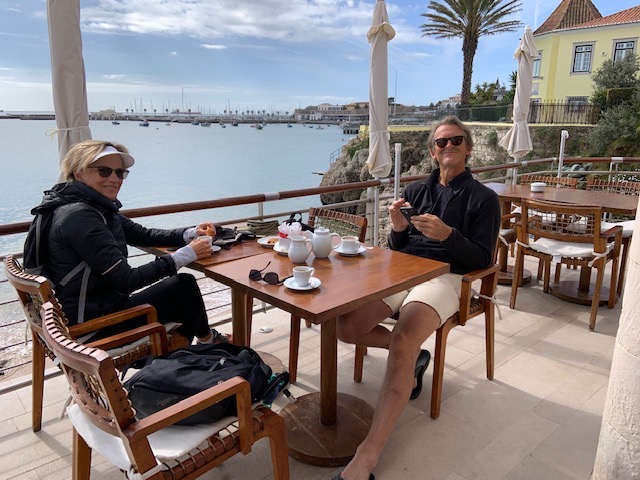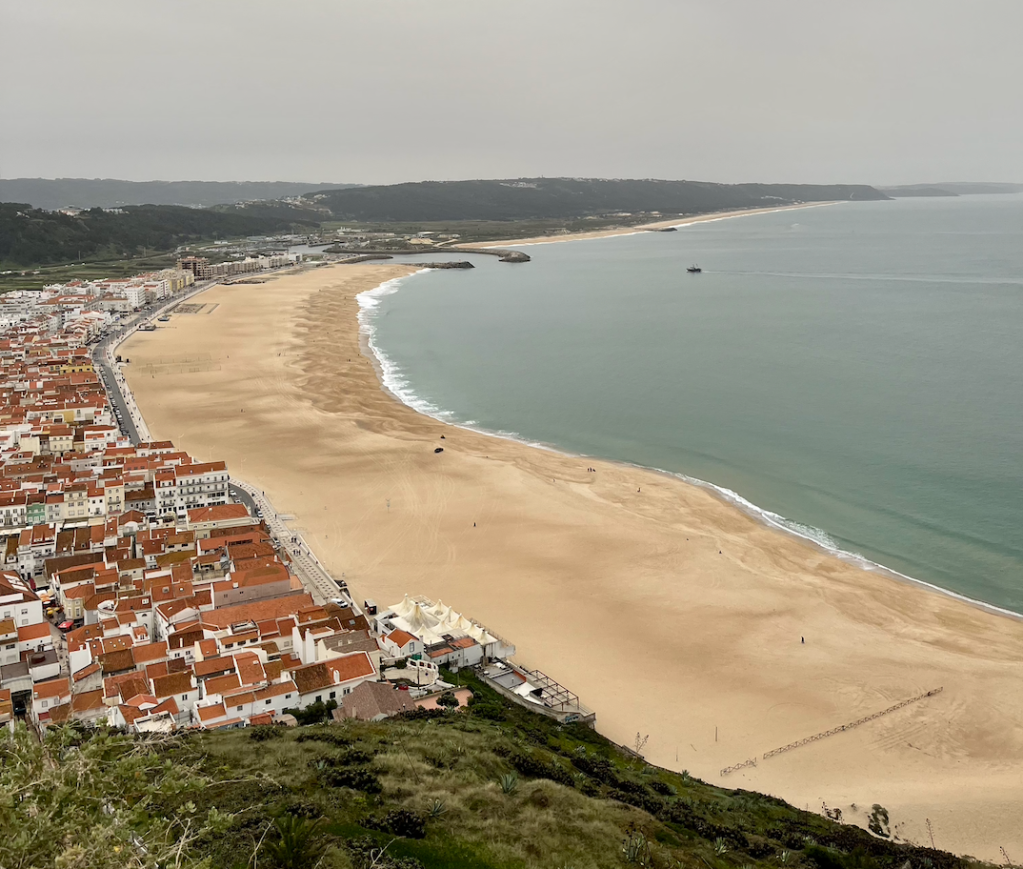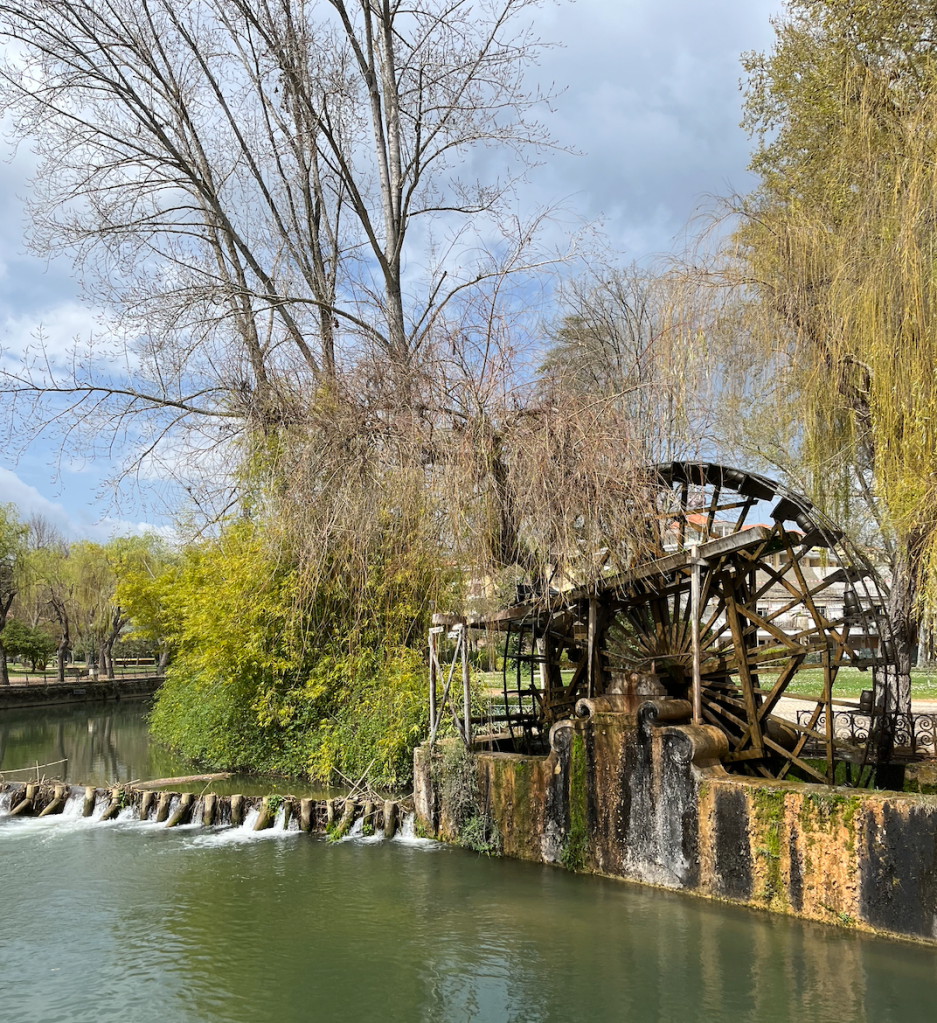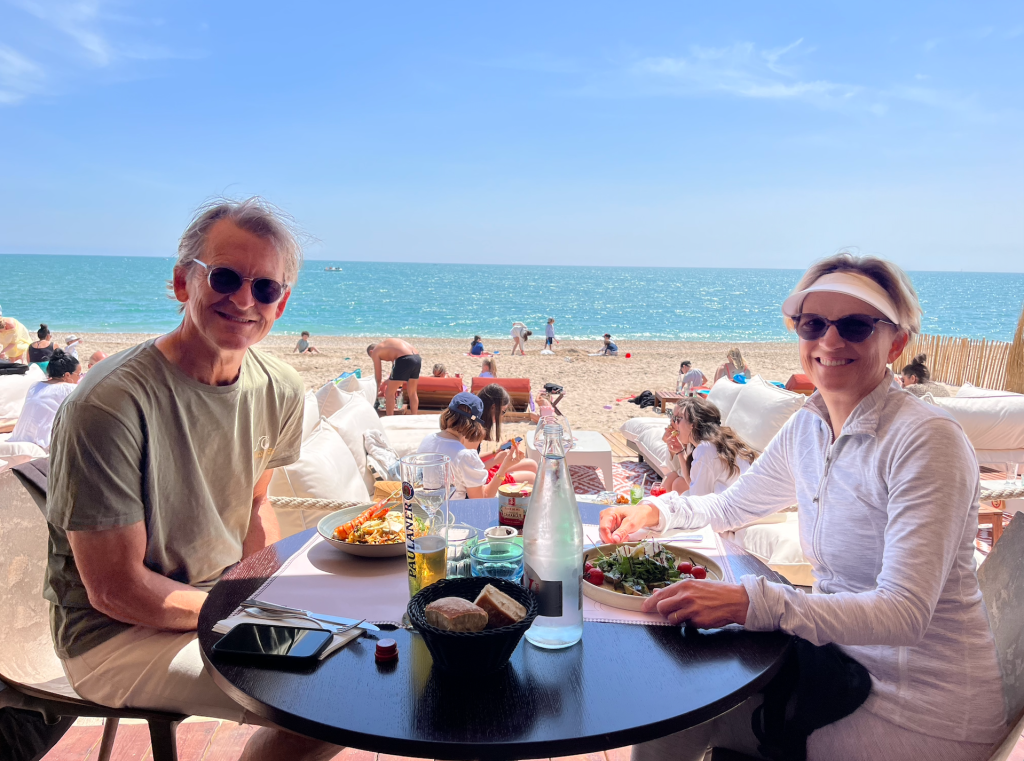

(To see more photos and highlights of our trip, please visit our Instagram account: @sylsteveeurope.)
Our month in Montpellier is drawing to a close and we have loved every minute of being here. Please read on to learn more about this fabulous city.
Montpellier is a city in the south of France, 13km from the Mediterranean and 200km from the Spanish border. It is the third-largest French city near the Mediterranean coast, behind Marseille and Nice. It has a very cosmopolitan feel, with a population of 285,000 people and many historical landmarks. Like Lisbon, it is a very young population with 15 universities. The university of Montpellier is one of the oldest universities in the world and was established in 1160. The Romans began building here in 333 AD. It’s pretty mind-boggling (especially as Canadians) to be surrounded by structures still standing from that era.

Southern France is similar to Portugal in the following ways:
- People are extremely friendly and welcoming.
- Food is incredible and fresh; farm to table produce is readily available
- Wine is delicious and inexpensive, mostly in the €10-€20 range.
- Weather in the spring is mostly sunny, averaging 18 – 22C.
- Laid-back and very sociable vibe
However, France (Montpellier) is different from Portugal in the following ways:
- We rarely hear English spoken (which we love because it forces us to practice our French)
- There are not many tourists this time of year
- Restaurants offer much more diversified/complex/delicious menus
- Less seafood (except for oysters which are cheap and plentiful); more breads of all types, fantastic cheeses and lots of varieties of meat.
- Generally, everything is more expensive in France
One of the definite highlights of our time here has been our Airbnb: It is by far one of the nicest accommodations we have ever stayed in, with a great view over the main plaza, Place de la Comédie, and a 5 minute walk to the train station.


Here are some more things that we love about Montpellier:
- The café culture: Cafés are everywhere and are always full. People gather in groups to socialize in cafés, and seem to stay for hours!
- There are no cars in the central old town: it is pedestrians and bicycles only. This is a delightful break from noisy Lisbon and we have noticed that it is actually like this in all of the old sections of the towns we have visited so far in L’Occitanie (name given to this region of France).
- Great infrastructure for cycling: Lots of bike lanes and paths. No car needed in Montpellier!
- Stunning 45 minute bike path all along Le Lez river to the ocean, meandering through the countryside.
- Very nice beaches with restaurants and and kite-surfers to watch for hours.
- 50 meter Olympic sized public pool, 5 minute bike-ride from our place (2.80eu/visit).
- City is very clean and well-maintained. Very few run-down buildings or graffiti.
- Farmers markets are everywhere. Les Halles Castellane is open every day (7h – 20h, Sun, 7h – 13:30h); Les Halles Laissac (7h – 17:30 every day); Le Marché des Arceaux (Tues. and Sat, 7h – 13:30h) and Le Marché Antigone (Wed. and Sun, 8h – 13:00h).
- Fresh-from-the-oven baguettes that melt in your mouth. We eat one every day.
- Amazing public transportation system of trams, buses and trains.
- Proximity to other great cities to visit by train: Carcassonne, Narbonne, Béziers, Sète, Nîmes, Arles, and Avignon are some of the places we visited for day trips, all within 2 hrs from Montpellier.
- Nearby golf. Following description from Steve: “I brought a Sunday bag with 8 clubs with me to Europe for our trip. It is small enough to be strapped to a bike. In Montpellier I would go to Golf Castelnau-le-Lez to hit balls. It is a range only. Balls are so, so, but it’s a nice place. Good cafe to get a beer and sandwich as well. I also biked over to Fontcaude golf a few times, taking the tram out to the last stop and then biking 15 minutes to the course. It’s a pretty good course, and the members are friendly although speak very little English. I learned a lot of golf terminology (swear words) in French there. They rent clubs there. There are a few other golf courses in the area and so if you have a car you can check them out.” (We didn’t have a car, so Steve was limited to golf courses that he could bike to from our Airbnb.)







Places to see in Montpellier:
Click here to see these spots on a Google map, indicated with red markers (zoom in).
Montpellier is easiest to explore on foot. We had rented bicycles from W Ville & Vélo (100eu/month each) but we ended up using them mostly just to go to the beach or cycle along Le Fleuve Lez (and Steve uses his to go to the golf range and course).
Place de la Comédie is the main square in Montpellier and it is a very lively place, lined with cafés, with street performers and people milling around or walking through it.
Branching out from La Place de la Comédie haphazardly heading in a North-West direction are pedestrian-only streets and lanes, filled with shops, cafés, squares, restaurants and parks. Here are some of our favourite spots:
- Place de la Canourgue: Lovely, quiet, tree-line square with nice cafés and restaurants. There are two hotels here that looks really nice: Hôtel du Palais (moderately priced) and Hôtel Richer de Belleval (luxury) (map).
- Promenade/Place du Peyrou: Gorgeous promenade and park with a fantastic flea market every Sunday (7h30 à 14h.) (map)
- Aqueduc des Arceaux: Beautiful Roman arched structure, once used to store and distribute water. Location of Le Marché des Arceaux Tuesday and Sat. mornings. (map)
- Rue Marioge is a really cute street just around the corner from Le Marché des Arceaux. Jaja La Fouine is a great vintage clothing store worth checking out. (map)
- Jardin des Plantes: Montpellier’s serene and beautiful botanical gardens (map)
- Esplanade Charles de Gaulle: Another tree-lined promenade, lined with restaurants on one side and a beautiful park on the other (map).
- Faculté de Médecine: Beautiful building housing the oldest medical university in the world (map).
- Cathédrale Saint-Pierre de Montpellier: Gorgeous, must-see, with a nice square in front with a very nice café, Le Mélody (great smoothies and crepes).(map)
- Place du Marché aux Fleurs: A lovely square with many restaurants and cafés. A great spot to catch the afternoon sun (map).
- Cute square in front of Toast’Tea restaurant (map) next to Église Saint-Roch de Montpellier. We had a nice brunch here.
- Le Fleuve Lez: This river flows through Montpellier and it’s a great spot for a bike ride or walk. (map)
- Antigone District: Dramatically different from the architecture of the old town. Huge neo-classical buildings line wide avenues with trees and fountains. Home of the Marché Antigone every Wed and Sun mornings. Be sure to walk/ride through this district right to Le Fleuve Lez. (map)
- Centre Commercial Le Polygone: A modern shopping centre with many stores, including a huge MonoPrix (grocery store) and an Orange mobile location to purchase a SIM card. (map)
- Musée Fabre: A wonderful museum with classic and modern art. (map)
- Le trompe-l’œil de la place Edouard-Adam: You need to see this to believe it: A huge mural painted on a flat wall that looks 3D. (map)
- Église Saint-Roch is a festive local hangout with bustling café terraces (map).
- Pomme de Reinette et Pomme d’Api is an amazing toy store with new and antique toys that you can spend hours exploring. (map)
- L’Arbre Blanc: This fascinating contemporary, award-winning residential tower on the shore of Le Lez. (map)
- Le Château de Flaugergues: This family-owned and run château was one of the highlights in Montpellier for us. Be sure to book lunch at Restaurant Folia, a tour of the château, and a wine-tasting. It is a 20 minute bike ride from Place de la Comédie, not the nicest ride, but worth it! (map)
- Pavalas-des-Flots: A waterfront community which lines the Lez Canal by the ocean. Many restaurants and cafés. Can be overcrowded on the weekend so stick to the weekdays. (map)
- Montpellier beaches: There are several beaches in the vicinity. Some were too far for us to reach on our bikes so I chose not to mention them here. Our favourites within biking distance are Plage Le Petit Travers and la plage Villeneuve-Lès-Maguelone because they are the most pristine and free of condos. Unfortunately, there are very few boardwalks along the Montpellier beachfront, so you end up biking on a road next to the beach far from the water. This was very disappointing for us. Walking is also difficult on the beachfront, as the sand does not have a hard flat surface to walk on.
- Cathédrale de Maguelone: This medieval church is near Plage Villeneuve-Lès-Maguelone, about an hour bike ride outside of Montpellier. It is on an island, surrounded with vineyards and is well worth the trip. Click here for bike route there and click here for alternative route back. Click here for more info on how to get there by car or tram/bus (scroll down to ACCÈS À LA CATHÉDRALE SAINT-PIERRE DE MAGUELONE then use Google translate). We had a nice lunch on-site at the Le Comptoir des Compagnons (call for reservations). 5 minutes away (by bike) is a gorgeous, pristine beach, la plage de Villeneuve-Lès-Maguelone.













Restaurants (Note: most good restaurants require reservations)
- L’Entrecôte: Mouth-watering steaks with a buttery-garlic-dijon sauce and perfect frites.
- Le Marvelous: Cute outside terrace, we had a very nice lunch. (map)
- Restaurant La Place: Right across from Le Marvellous. Dinner was excellent.
- La Morue: Great vibe, family-owned, mostly seafood. (map)
- Coldrip Food & Coffee: Good coffee and brunch with outdoor seating. (map)
- Napoleon Dynamite: Restaurant and café in a gorgeous square (Place de la Canourgue). (map)
- Café Solo: Good coffee with outdoor seating. (map)
- Carré-Mer: On la plage de Villeneuve-Lès-Maguelone, great outdoor terrace (but really expensive. You’re definitely paying for the view). (map)
- Albatros: On Plage Rive-Droite Palavas-les-Flots, great outdoor terrace and reasonably priced. (map)
- Le Comptoir des Compagnons: A lovely spot for lunch in a picture-perfect setting, with vineyards and the sea in the background. Right next to Cathédrale de Maguelone (see #22 above).



Tips:
- Montpellier-france.com is a good site for information on Montpellier.
- Click here to learn about how to order coffee in France. We have not figured out how to order a coffee with low-fat cream (which is how Steve likes it). Not sure if they offer it in restaurants.
- “Paiement sans contact” (payment with Apple Pay) is everywhere, however, some small stores have a cash only policy for under 10eu.
- Most restaurants close at 2:30pm for lunch and re-open for dinner.
- Most stores and many restaurants are closed on Sundays.
- Our favourite place for baguettes is Patisserie Teissier (map) which is open every day including Sundays. We prefer the “Grand siècle” baguette: it’s a little wider than the regular baguette.
- Monoprix is a chain of grocery stores. There are two in Montpellier: a huge one in Centre Commercial Le Polygone (click here for hours) and a smaller one in Place de la Comédie which is open on Sundays (click here for hours).
- La Gazette is a weekly newspaper sold every Thursday with all of the upcoming week’s cultural events (2eu) that you can find the local Tabac-Presse.
- The tram (Tam Voyages) is a sleek, quiet, electric tram that provides transportation everywhere in Montpellier. You can buy a 10 ride ticket (10eu) from the Office du tourisme de Montpellier on the east end of Place de la Comédie (map). Validate your ticket once in the tram. Bikes are allowed in the tram and masks are mandatory.
- You can get to Montpellier beaches on public transport. We have taken our bikes on Tram #3 from the Montpellier St-Roch train station then cycled to the beaches instead of cycling the whole way there. Apparently you can also get to the beaches on public transport without bikes (but we haven’t tried). Click here to learn how.
- Masks are mandatory on all forms of public transportation.
- Visit the SNCF website to buy train tickets. You can order from the desktop version or use the app. La Gare Montpellier Saint-Roch is a 5 minute walk from la Place de la Comédie. Note that prices go up significantly if you buy last-minute so try to plan ahead of time. Tip: Create profiles for you and your travel companions for faster future bookings. Also, when you book a ticket, make sure that you have chosen the most direct (ie. shortest) route.
- Some trains have assigned seating while others do not. Sometimes a conductor will check your ticket on board but most often they will not. There is free wifi on the trains.
- You need to know which direction your train is heading (ie, the final destination) before you can find the track (“voie”) to wait on. This can be tricky, so the best way around this is to look at the departures (“Départs”) screen at the train station and look for the train with the exact same time of the departure on your ticket. This will likely be your train. If you are not sure, just ask someone waiting on the platform. “Est-ce que ce train va à …?”
- When visiting different towns, do some research ahead of time (or on the train) so that you have a rough game plan of what you want to visit. It is helpful to create a Google map of where you want to go so that you don’t miss anything.
- Upon arriving at a new town, be sure to head to “Les Halles” to check out the main market. Every one we saw was incredible! Note that many close before 14h-15h and most are closed on Sundays.
- When looking for restaurants, open Google maps to where you are visiting and hit “restaurants” then tap on each restaurant to see their rating.
- There are a lot of smokers in France (curiously, mostly women). It’s hard to avoid cigarette smoke in outdoor restaurants and cafés, unfortunately. Smoking is not permitted inside, but it is permitted on an outside terrace, even if it’s covered and enclosed.
- Pedicures are very expensive here: 40 – 55 euros. If you must get one, ask for a “beauté des pieds avec varnis”.










Nearby towns that we visited and highly recommend, all easily accessible by train:
Click here for a map of these places, indicated with purple markers (Zoom out).
- Carcassonne (*must do)
- Narbonne
- Béziers
- Sète
- Nîmes
- Arles
- Avignon (*must do)
- Carcassonne: This is one of our favourite towns we visited. It has the largest castle we have ever seen (Château Comtal) and Steve was obsessed with it. Below is our itinerary. Click here for a map of our walking route.
- Place Carnot
- La Cathédrale Saint-Michel de Carcassonne
- Château Comtal in the walled Cité de Carcassonne. Avoid the lines and buy your tickets online here.
- Lunch at Méli et Zéli (get the Cassoulet and Fois Gras)
- La basilique Saint-Nazaire
- Sheep watching in the Parc de Camin del Garric
(NOTE: Continue scrolling down to read details of all of these towns that we visited)




2. Narbonne: The walk from the train station to the old town takes about 10 minutes and is not very nice, but once you are there, it is worth it! Click here for map of our walking route.
- Palais des Archeveques
- Donjon Gilles Aycelin (climb up tower)
- Cathédrale Narbonne
- Canal de la Robine
- Les Halles de Narbonne (have lunch at Las Tapas de la Clape)
- Place Thérèse Léon Blum




3. Béziers: This is a small but cute town with not a lot to see or do but we still enjoyed it. The beautiful park Plateau des Poètes and the view from the Cathédrale Saint-Nazare tower made the trip totally worth it. Unfortunately, there was construction on Les Allées Paul-Riquet and le Pont Vieux but hopefully if you go there this will be completed. Click here for a map of our walking route.
- Plateau des Poètes
- Les Allées Paul-Riquet
- Les Halles de Beziers (with great outdoor restaurants)
- Chapelle des Penitents
- Cathédrale Saint-Nazare (tower closed btn 12-14h)
- Pont Vieux
- Trompe l’oeil on Rue Viennet
- Les 9 Écluses de Fonseranes (we didn’t see this but it looks cool).




4. Sète: Sète is a charming fishing village, just 15 minutes outside of Montpellier by train. We went during the annual “Escale à Sète” festival for tall ships and it was fun to see them but it was very crowded. We still enjoyed ourselves and had delicious oysters for lunch at the outdoor terrace of Les Halles de Sète.
The second time I visited Sète (while Steve was golfing), I brought my bike on the train and cycled to town then along the waterfront all the way to beautiful Plage Baleine. I settled into a beach “matelas” at Restaurant La Canopée (14eu/day, 7eu/half day) with my book and ordered “un café frappé. Heaven. Click here for our walking route and here for my bike route.
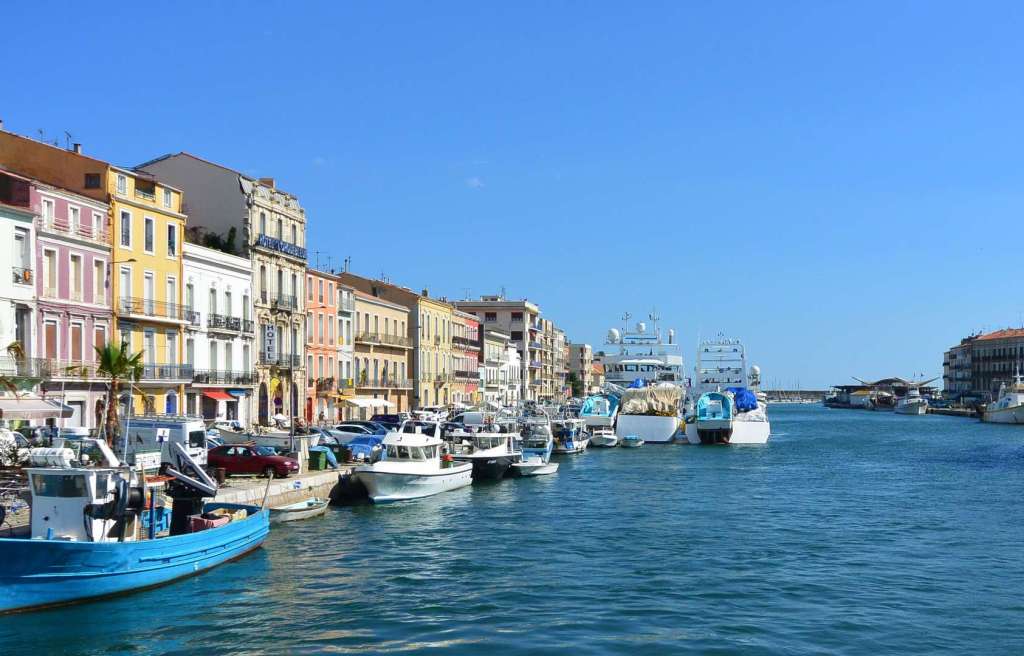




5. Nîmes: As soon as you leave the Nîmes train station, you will see the beautiful boulevard Les Allées Jaurès which you will walk along on the way to the Nîmes Roman Arena. After you pass the Roman La Maison Carrée, walk along the beautiful canal next to the Quai de la Fontaine on the way to the stunning Jardin de la Fontaine. Climb up the stairs to the top of the hill to see La tour Magne and a wonderful view of the city. Have iced coffee (Café frappé) at Les Tables de la Fontaine. Click here for our walking route.
- Nîmes Roman Arena
- Les Halles de Nîmes
- La Maison Carrée
- Jardin de la Fontaine
- La tour Magne
- Les Tables de la Fontaine




6. Arles: This was overall a bit of a disappointment for us but the impressive Arène d’Arles made it a worthwhile trip. Nonetheless, Arles was the least favourite of the towns we saw in L’Occitanie. Click here for our walking route.
- Arène d’Arles
- Théâtre Roman
- Jardin d’été
- Fondation Vincent Van Gogh
- Eglise Saint-Trophime and cloître
- Place de la République
- Place du Forum
- Cryptoportiques du Forum
- Thermes de Constantin
- Les Alyscamps





7. Avignon: Oh my gosh, we loved Avignon. From the train station, walk up Cour Jean-Jaures to Place de l’Horloge, a beautiful and lively square with restaurants, cafés, artists, musicians and a carousel. Visit the stunning Palais des Papes and be sure to grab an interactive tablet for your tour. When you scan the QR code in each room, your screen will come alive with a representation of what the room would have looked like in its prime. Afterwards, head up to the Jardin des Doms, a beautiful park on a hill overlooking the famous Pont D’Avignon (Pont Saint-Bénézet) on the river below (PS. when you buys tickets for the Palais des Papes tour, do not pay extra for tickets to the park and bridge – as we did – because you do not need them. We didn’t walk down to the bridge, we just took pics from the park). We had a great lunch at Coeur d’Artichaud, sitting outside in the sun, then walked around the charming streets and alleys of Avignon. On our way back to the train station we stopped at Café Le Square in a lovely park for cold drinks (Steve, beer; me, Orangina). We wanted to go to Les Halles d’Avignon which is supposed to be fantastic but unfortunately, we were too late and it was closed. Click here for our walking route.
- Cour Jean-Jaures
- Place de l’Horloge
- Palais des Papes (avoid line-ups and purchase tickets here)
- Jardin des Doms
- Pont D’Avignon (Pont Saint-Bénézet)
- Coeur d’Artichaud
- Les Halles d’Avignon
- Café Le Square






Have you been to this part of the world? What are some of your favourite places? Please leave comments below, thank you!
(Next month’s destination: Gordes, France. Stay tuned!)
PS. Here’s a quick video about Montpellier (in French):
